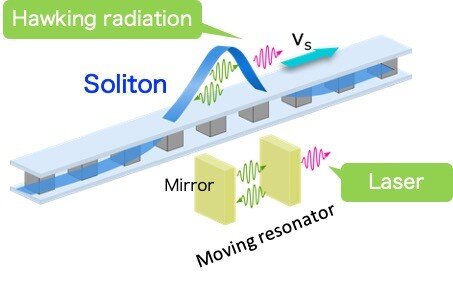Almost half a century ago, Stephen Hawking proposed a groundbreaking notion that a black hole can emit electromagnetic radiation, now known as Hawking radiation. The process is the result of the amalgamation of general relativity and quantum mechanics, and is thought to be impossible to observe in nature as the radiation emitted from a typical black hole event horizon would be extremely small and diluted by the Universe’s background noise.
But that hasn’t stopped physicists from attempting to simulate it. Previous studies have observed the radiation in a sonic analogue of a black hole, where it introduced exciting possibilities to learn more about Hawking radiation and related astrophysical phenomena from bench-top lab experiments.
Now, a new proposal suggests generating a quantum circuit that acts like a “black hole laser”, essentially a system that could theoretically amplify Hawking radiation from the horizon of a black hole and make it even more observable.
Black holes.
Despite how complicated a black hole sounds, the fundamental principle underpinning the phenomenon is relatively straightforward.
Imagine really, really strong winds (fictitiously faster than the speed of sound) blowing in your direction. You try to scream at your friend standing at the other end, but the fictitious wind sweeps your screams downstream faster than the sound waves can travel towards your friend. And you can no longer be heard.
Something similar happens when you somehow find yourself falling into a black hole. It’s a region in spacetime where gravity is so strong that it warps the universe into a grotesque hall of mirrors—even light can’t escape its grasp. Now, swap spacetime for another material such as water and make it flow so rapidly that nothing else can escape. Ta-da! You now have a rudimentary model of a black hole system.
White holes.
Since researchers can’t observe Hawking radiation in nature, Haruna Katayama from Hiroshima University wants to bring Hawking radiation to researchers.
To achieve this, she designed a quantum-circuit laser theory using an analogue black hole and a white hole—a reverse black hole where waves can only escape, but cannot enter—as a resonator. Next, she introduced a metamaterial—any material engineered to have properties not found in naturally occurring materials—so that particles within it can move faster than the light that passes through.

An illustration of quantum-circuit black hole lasers. Scientists from Hiroshima University proposed black hole lasers using quantum Josephson metameterial transmission lines. Solitons play the role of resonators in laser devices. Photo credits: Haruna Katayama/Hiroshima University
This setup makes it possible for Hawking radiation to travel back and forth between the black and white holes—like a laser. But to amplify it, Katayama also proposes using the Josephson effect, which allows a superconducting current to become quantised without requiring any voltage, creating a soliton in the process. A soliton is a localised, self-reinforcing waveform that maintains speed and shape until external factors disturb the system.
Since Hawking radiation is produced as particle pairs having entangled quantum mechanical states, with one inside and one outside the horizon, researchers can then measure and evaluate the amplified Hawking radiation emitted from the soliton.
Advancing quantum technology.
Understanding the existence of Hawking radiation could provide new insights into the complex relationship between quantum mechanics and general relativity, bringing researchers closer to solidifying a unified theory of everything.
On the other hand, practical applications of developing quantum-circuit black hole lasers could be in quantum communication, said Katayama. Being able to build such a system could lead to advancements in quantum computing technologies, pushing us one step closer to a practical quantum era.




































